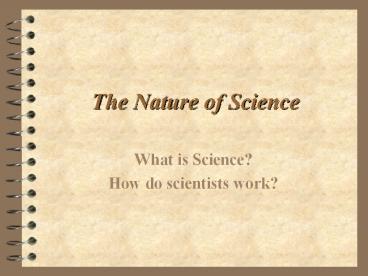The Nature of Science - PowerPoint PPT Presentation
Title:
The Nature of Science
Description:
The Nature of Science What is Science? How do scientists work? Nature of Science Goal of Science To understand the world around us EX. Does life appear from non ... – PowerPoint PPT presentation
Number of Views:46
Avg rating:3.0/5.0
Title: The Nature of Science
1
The Nature of Science
- What is Science?
- How do scientists work?
2
Nature of Science
3
Goal of Science
- To understand the world around us
- EX. Does life appear from non-living matter?
- To explain events by making predictions
- EX. Life doesnt appear from non-living matter.
- To investigate predictions
- EX. Setting up an experiment to see if life comes
from non-living matter, or from living things
4
How scientists work
5
Observations- Gathering evidence
- It all starts here!
- Using SENSES to gather data
- Quantitative
- Observation using numbers and measurement
- Can you make a quantitative observation in this
classroom? - Qualitative
- Observation that doesnt involve numbers
- EX. Maggots are on raw meat
- Can you make a qualitative observation in this
classroom?
6
Inferences- Interpreting the Evidence
- INTERPRETATION based on observation and prior
knowledge or experience - EX. Maggots come from raw meat.
- Observation Maggots are on the meat
- Prior knowledge Maggots have always been found
on raw meat - Can you make an inference about something in the
classroom? - Observation
- Prior knowledge
7
Hypothesis- Explaining the Evidence
- The answer to a BURNING QUESTION!
- Only useful if it can be tested!
- Evidence must be gathered and tested.
- Example
- Question Do living things come from non-living
matter? - Hypothesis Living things do not come from
non-living things. - We now must set up an investigation to test our
hypothesis!!!! - What is the process called that scientists use?
- SCIENTIFIC METHOD!
8
The Scientific Method
- State the problem (the burning question)
- Form a hypothesis (answer to burning question)
- Design a controlled experiment
- Collect organized data
- Analyze data
- Form a conclusion (Was your hypothesis correct?)
- Peer evaluation (Can your experiment be retested
and always get same results?)
9
Definitions
- Variable
- Things that can be manipulated or changed by
scientist during experiment - A controlled experiment tests ONE variable
- Independent (Manipulated variable)
- Manipulated by scientist
- Graphed on X-axis
- Dependent (Responding Variable)
- Responsive variable (tested against independent)
- Graphed on Y-axis
- Controlled Variables
- Things that must be kept constant during
experiment - If altered, can be used to show error in
experiment
10
Setting up a Controlled Exp.
- What does it mean to be a CONTROLLED experiment??
11
1st Step Ask a Question
12
Redis Experiment Scientific Method at work!
- Problem
- How do living things arise?
- Hypothesis
- Old view Living things arise spontaneously from
non-living matter. (spontaneous generation) - Maggots arise spontaneously on raw meat.
- New idea (proposed by Francesco Redi) Living
things come from living things. - Maggots come from flies that land on the meat.
13
2nd Step Form a Hypothesis
14
Redis Experiment Scientific Method at work!
- Design a controlled experiment to test hypothesis
- Redi used two jars, each with meat. One jar
covered with gauze, one jar without gauze. - Can you list the things that need to be kept
constant (controlled variables)? - Type of meat, type of jar, temperature, length of
exposure - Can you name the independent variable?
- gauze
- Can you name the dependent variable?
- maggots
15
3rd Step Design and Conduct Exp.
16
Redis Experiment Scientific Method at work!
- Collect data
- Written, drawings, etc
- Redis data
- Jar with no gauze maggots
- Jar with gauze no maggots
- Analyze data
- Redi figured that the gauze prevented flies from
landing on the meat - Draw a conclusion
- Redis hypothesis was correct. Living things do
come from living things. - Peer evaluation
- Redis experiment was tested and retested by
others including Louis Pasteur
17
Step 4 Analyze Results
18
Step 5 Draw a Conclusion

